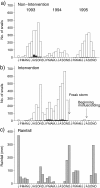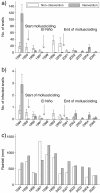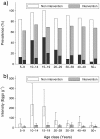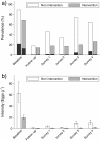Long term study on the effect of mollusciciding with niclosamide in stream habitats on the transmission of schistosomiasis mansoni after community-based chemotherapy in Makueni District, Kenya
- PMID: 23596985
- PMCID: PMC3652733
- DOI: 10.1186/1756-3305-6-107
Long term study on the effect of mollusciciding with niclosamide in stream habitats on the transmission of schistosomiasis mansoni after community-based chemotherapy in Makueni District, Kenya
Abstract
Background: Schistosoma mansoni infection is a persistent public health problem in many Kenyan communities. Although praziquantel is available, re-infection after chemotherapy treatment is inevitable, especially among children. Chemotherapy followed by intermittent mollusciciding of habitats of Biomphalaria pfeifferi, the intermediate host snail, may have longer term benefits, especially if timed to coincide with natural fluctuations in snail populations.
Methods: In this cohort study, the Kambu River (Intervention area) was molluscicided intermittently for 4 years, after mass chemotherapy with praziquantel in the adjacent community of Darajani in January 1997. The nearby Thange River was selected as a control (Non-intervention area), and its adjacent community of Ulilinzi was treated with praziquantel in December 1996. Snail numbers were recorded monthly at 9-10 sites along each river, while rainfall data were collected monthly, and annual parasitological surveys were undertaken in each village. The mollusciciding protocol was adapted to local conditions, and simplified to improve prospects for widespread application.
Results: After the initial reduction in prevalence attributable to chemotherapy, there was a gradual increase in the prevalence and intensity of infection in the non-intervention area, and significantly lower levels of re-infection amongst inhabitants of the intervention area. Incidence ratio between areas adjusted for age and gender at the first follow-up survey, 5 weeks after treatment in the non-intervention area and 4 months after treatment in the intervention area was not significant (few people turned positive), while during the following 4 annual surveys these ratios were 0.58 (0.39-0.85), 0.33 (0.18-0.60), 0.14 (0.09-0.21) and 0.45 (0.26-0.75), respectively. Snail numbers were consistently low in the intervention area as a result of the mollusciciding. Following termination of the mollusciciding at the end of 2000, snail populations and infections in snails increased again in the intervention area.
Conclusion: The results of this study demonstrate that in the Kenyan setting a combination of chemotherapy followed by intermittent mollusciciding can have longer term benefits than chemotherapy alone.
Figures






Similar articles
-
Distribution of the schistosome intermediate snail host Biomphalaria pfeifferi in East Africa's river systems and the prevalence of Schistosoma mansoni infection.Trans R Soc Trop Med Hyg. 2025 Mar 7;119(3):253-265. doi: 10.1093/trstmh/trae115. Trans R Soc Trop Med Hyg. 2025. PMID: 39656884 Free PMC article.
-
Observations on the effects of different chemotherapy strategies on the transmission of Schistosoma mansoni in Machakos District, Kenya, measured by long-term snail sampling and cercariometry.Parasitology. 1994 Nov;109 ( Pt 4):443-53. doi: 10.1017/s0031182000080690. Parasitology. 1994. PMID: 7800412
-
Efficacy of praziquantel and reinfection patterns in single and mixed infection foci for intestinal and urogenital schistosomiasis in Cameroon.Acta Trop. 2013 Nov;128(2):275-83. doi: 10.1016/j.actatropica.2013.06.007. Epub 2013 Jun 20. Acta Trop. 2013. PMID: 23791803
-
Epigenetic modulation, stress and plasticity in susceptibility of the snail host, Biomphalaria glabrata, to Schistosoma mansoni infection.Int J Parasitol. 2016 Jun;46(7):389-94. doi: 10.1016/j.ijpara.2016.03.003. Epub 2016 Apr 4. Int J Parasitol. 2016. PMID: 27056272 Review.
-
Analysis of the dynamics of transmission of human schistosomiasis in the highveld region of Zimbabwe. A review.Trop Med Parasitol. 1988 Sep;39(3):187-93. Trop Med Parasitol. 1988. PMID: 3143147 Review.
Cited by
-
Water-based interventions for schistosomiasis control.Pathog Glob Health. 2014 Jul;108(5):246-54. doi: 10.1179/2047773214Y.0000000149. Pathog Glob Health. 2014. PMID: 25175875 Free PMC article. Review.
-
Posttreatment changes in cytokines induced by Schistosoma mansoni egg and worm antigens: dissociation of immunity- and morbidity-associated type 2 responses.J Infect Dis. 2014 Jun 1;209(11):1792-800. doi: 10.1093/infdis/jit826. Epub 2013 Dec 19. J Infect Dis. 2014. PMID: 24357629 Free PMC article.
-
Systematic Review and Meta-analysis of the Impact of Chemical-Based Mollusciciding for Control of Schistosoma mansoni and S. haematobium Transmission.PLoS Negl Trop Dis. 2015 Dec 28;9(12):e0004290. doi: 10.1371/journal.pntd.0004290. eCollection 2015 Dec. PLoS Negl Trop Dis. 2015. PMID: 26709922 Free PMC article.
-
The effect of increasing water temperatures on Schistosoma mansoni transmission and Biomphalaria pfeifferi population dynamics: an agent-based modelling study.PLoS One. 2014 Jul 2;9(7):e101462. doi: 10.1371/journal.pone.0101462. eCollection 2014. PLoS One. 2014. PMID: 24987963 Free PMC article.
-
Gene drives for schistosomiasis transmission control.PLoS Negl Trop Dis. 2019 Dec 19;13(12):e0007833. doi: 10.1371/journal.pntd.0007833. eCollection 2019 Dec. PLoS Negl Trop Dis. 2019. PMID: 31856157 Free PMC article. Review.
References
-
- Butterworth AE, Sturrock RF, Ouma JR, Mbugua GG, Fulford AJC, Kariuki HC, Koech D. Comparison of different chemotherapy strategies against Schistosoma mansoni in Machakos District, Kenya: effects on human infection and morbidity. Parasitology. 1991;103:339–355. doi: 10.1017/S0031182000059850. - DOI - PubMed
-
- Butterworth AE, Fulford AJC, Dalton PR, Dunne DW, Ouma JR, Sturrock RF. Longitudinal studies on human schistosomiasis. Philos Trans R Soc Lond B Biol Sci. 1988;B321:495–511. - PubMed
Publication types
MeSH terms
Substances
LinkOut - more resources
Full Text Sources
Other Literature Sources
Research Materials

